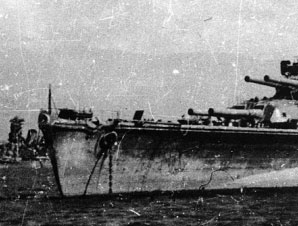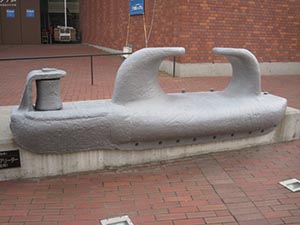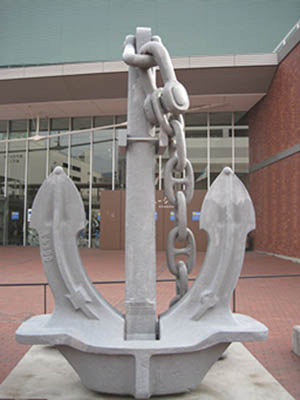Shackles

(Bow of IJN Nagato showing chocks and anchor chain just before the battle of Leyte Gulf, 1944. Photo USN).
Browsing around the Navy Yard in Yokosuka looking for likely opportunities, one of our officers found an anchor stamped with the name “Nagato.” It was a huge thing, as befits a hook intended for a dreadnaught and nothing would do but we must have it onboard to replace the one lost in the chaos of the last American bombing of the harbor.
Never mind that it weighed twenty tons.
The operation was carefully planned. Personnel at the Yard were assigned to pick the anchor up and put it on the deck of the large tank lighter. A floating crane was to accompany the lighter to our side, draw out the end of our anchor chain and lower it to the deck of the tank lighter where we would be ready to shackle it on the anchor. Then, as we heaved in on the chain, the crane was to pick up the anchor, and when we had all but a few links hove in, they were supposed to let the anchor down until it hung from the chain and go their way in peace.
It didn’t work like that. The anchor was in the tank lighter, all right, but the Jap-operated crane hooked onto it and hoisted it out without bothering with our chain. They hoisted it right up over our deck where it slipped and flopped about as the crane teetered on the swells, lending its full weight to the ensuing negotiations. The deck began to fill with jabbering Nipponese, some coming up over the side and others inexplicably from the rear.
I was standing fast, insisting that they put it back in the lighter and start all over again, but I noticed the whites of the boatswain’s mate’s eyes as they flashed between the crowd, the mighty anchor and its pendulous arc.
Although the day was cold, beads of sweat glistened on the Boatswain’s forehead. So, I let them lower it on deck, which they accomplished with scarcely a bump. Then, having delivered the anchor, they were all for getting back to their warm quarters. If I had let them, the anchor would have stayed right there for as long as the battleship lasted. We are at the mooring outside the breakwater, and except for the floating crane there was no way to move it. So, I made them haul a hundred feet of chain out through our bow chocks while our crew let down the safety lines on that part of the deck.

(Chock from an IJN Battleship on display at the Kure Naval Museum. Photo Punynari)
The Japs brought the chain back on board and put it down by the anchor, leaving a bight of chain hanging over the side. The boatswain was ready to shackle it onto the anchor but the shackle weighed four hundred pounds and took considerable manhandling and persuasion with a maul. Although our crew could have handled it without much trouble, the Japanese had gotten into the spirit of the thing, swarming all over it at the risk of getting their fingers nipped right off.
They were a good-natured bunch, and when all was ready, the crane picked up the anchor again with chain attached and lowered it to their own deck. We heaved in on the chain. There was an anxious moment when the two ships shared the weight between them; then they had to unshackle their hold on the anchor with the awful risk of being crushed between the ships.
They managed to do it, and broke away clean. Then we heaved in on the chain until the anchor nestled into the hawse pipe without any fuss at all.
It had come home.

(Anchor at the Kure Naval Museum from the battleship Mutsu, sister ship to Nagato. Photo Punynri).
Ed Note: The replacement anchor is now under the hulk of the inverted hull of Nagato with all 1200 feet of anchor chain.
Copyright 2015 Vic Socotra
www.vicsocotra.com
Twitter: @jayare303
